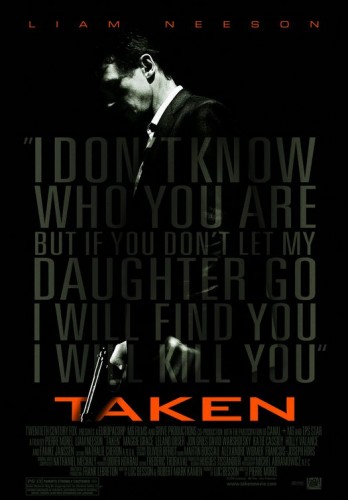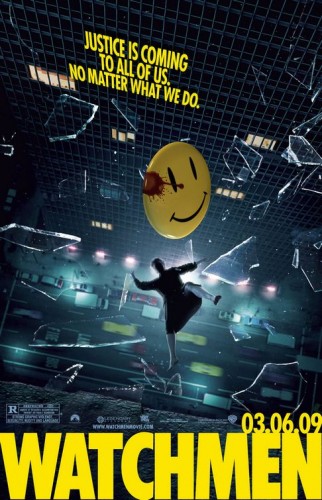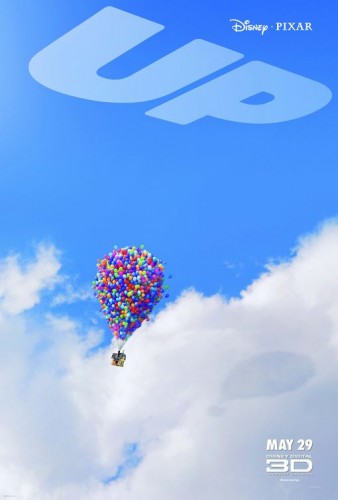One thing we at Place to Be Nation like to celebrate is the subjectivity inherent in entertainment — be it in wrestling, comics, music, television or, indeed, film. With that in mind, ten members of the PTBN staff will be picking the movies of the PTB generation. In this series, panel members will collect their five favorite films of each year, beginning with the year in which the oldest writer was born — 1976. The only rule given to each contributor was to provide his or her own criteria. Some writers may go with the most artistic films, while others might side with the most iconic blockbusters. We welcome your lists on Facebook and Twitter. Each staff member has submitted a list of five movies from 2009 ranked 1 through 5. A first-place vote is worth five points, a second-place vote worth four points, and so on. Using that point system, we have identified the top 5 movies of 2009.
2009 saw perhaps the most divided panel yet, as all 10 members voted for a different film at No. 1. But before we reveal the top 5, let’s see the movies that received votes, but fell short of making our final list.
Honorable Mentions

Taken — 9 points
Star Trek — 8 points
The Hurt Locker — 8 points
Avatar — 6 points
Black Dynamite — 6 points
District 9 — 6 points
A Serious Man — 5 points
Sherlock Holmes — 5 points
The Fantastic Mr. Fox — 5 points
Angels and Demons — 4 points
The Hangover — 3 points
I Love You, Man — 3 points
Adventureland — 3 points
Precious — 3 points
Up in the Air — 3 points
The Blind Side — 2 points
Away We Go — 1 point
Moon — 1 point
Transformers: Revenge of the Fallen — 1 point
And now, let’s see the top 5 movies of 2009, as voted by the Place to Be Nation staff.
4 (tie). (500) Days of Summer
10 points, ranked by 3 of 10 voters, highest ranked by Steve Wille at No. 1
Steve Wille: If one would make a list of the most clichéd movie genres, romantic comedies would rank towards the top. So it takes a special film to break the tropes of the genre and standout as an original movie. (500) Days of Summer literally tells the viewer in the beginning of the movie that it’s atypical and then proves it. Written in a non-linear format, director Marc Webb follows the relationship between Tom (Joseph Gordon-Levitt), a failed architect turned greeting card writer, and the titular character Summer, played by an expertly cast Zooey Deschanel. Summer’s gorgeous and shows interest in Tom, who instantly falls deeply for her. The expectation is that the two will ride off into the sunset together, but as previously stated, this isn’t a typical “chick flick.” Summer never quite gives all of herself to Tom, despite both characters’ best intentions, and, despite already knowing the ending from the opening credits, the viewer still roots for the couple to make things work.
And why is it so easy to fall into this trap? It starts with the likability and incredible chemistry of the two leads. Gordon-Levitt brings an air of coolness to most of the films he appeared during this time period, starting with the underrated Manic and critical darling Brick. He’s believable as Tom, and incredibly easy to identify with. Deschanel’s casting works so well because the audience sees the actress as similar to the character. In anything Deschanel does, whether in movies like this and Elf, television shows such as New Girl, or her music career as part of the throwback duo She and Him, she commands the viewer’s attention. She has the appearance of someone who would be approachable, but an insane amount of talent that places her just out of reach, similar to the character of Summer. The chemistry stems from a then 8-year friendship between the two actors, which translates beautifully to the screen. For proof, I present a homemade music video from the two, filmed in 2011, that compares to videos of kittens in terms of cuteness.
When you mix this chemistry with Webb’s artistry and homage to film greats of the past, you get an easily rewatchable movie that stands out from the tired romantic comedies generally seen at the multiplex.
4 (tie). Zombieland
10 points, ranked by 3 of 10 voters, highest ranked by Russell Sellers at No. 1
Nick Duke: It’s hard to put into words exactly why I enjoy Zombieland so damn much, but I’ll give it my best shot. Start with the premise — a cross-country road trip movie that sends up all the tropes of the zombie genre along the way. It’s hilarious throughout, and even a little emotional at times when it wants to be. This is due in large part to the abilities of the four leads — Jesse Eisenberg, Woody Harrelson, Emma Stone and Abigail Breslin.
Eisenberg was able to cement himself as a bonafide big screen star, clearing the way for him to take bigger roles in films such as The Social Network and the upcoming Batman v. Superman: Dawn of Justice. Emma Stone may have been at the peak of her attractiveness here, mainly because in addition to being smoking hot, she’s also hilarious, down-to-earth and believably attainable. Breslin is able to move past her role in Little Miss Sunshine to play a more grown-up character while at the same time keeping just a tad of childlike tendencies that help to keep her grounded.
But, I say all of those wonderful things about three of the leads to say this — none of them can compare to Woody freakin’ Harrelson. Harrelson nails every scene in this movie. Every damn one. His Tallahassee is simultaneously terrifying, hilarious, badass and a bit vulnerable. He tears through the movie, leaving a trail of blood and guts on his journey to find one last Twinkie. Eisenberg may have been the movie’s point of view character, but Harrelson is the character that’ll keep you coming back for more.
Oh, and I won’t spoil a 5-year-old movie here, but if you haven’t seen Zombieland, watch it for THAT cameo alone. Simply brilliant.

3. Watchmen
13 points, ranked by 4 of 10 voters, highest ranked by Aaron George at No. 1
Greg Phillips: Somewhat of a divisive film among comic book fans, Zack Snyder’s Watchmen is decidedly less divisive amongst movie critics. I think the divide comes about because of just how revered the original graphic novel, written by Alan Moore and drawn by Dave Gibbons, is among followers of the comic book medium. In my opinion, it’s the greatest work ever published in comics.
Jackie Earl Haley steals the show as Rorschach, arguably the most popular character from the comic, but Jeffrey Dean Morgan, Carla Gugino, Billy Crudup and Patrick Wilson also deliver knockout performances that made this fanboy especially happy. The film took a few liberties, notably altering the ending. While opinions on the change vary, I felt it worked far better on screen than the original would have, and it served the narrative better for what the film was trying to achieve. The visuals are stunning, the sound is magnificent, and it’s a film everyone should see at least once, regardless of how they feel about it.
None other than the great Roger Ebert awarded the film four out of four stars. “After the revelation of The Dark Knight, here is Watchmen, another bold exercise in the liberation of the superhero movie,” he wrote. Well said, Mr. Ebert.

2. Up
14 points, ranked by 4 of 10 voters, highest ranked by Anthony Estrada at No. 1
Anthony Estrada: Carl sits alone in a movie theatre. It feels like a customary occurrence for him. An explorer appears on the big screen and Carl is alive in the moment. The movie ends and Carl is walking home, alone again, when he hears a voice in an abandoned house. The voice belongs to Ellie, a gap-toothed spitfire who takes an immediate shine to Carl’s gentle reserve. Ellie and Carl become instant friends. In a charming, marvelous, heartbreaking montage, spanning seventy years, they share a life together. They play, plan, compromise, endure, and work – Carl as a balloon vendor at the zoo. My wife, Katie, and I took our first married steps up the aisle to the music that accompanied this scene. The montage ends with Ellie’s passing. For a second, your breath stops. The movie continues.
It’s a gut punch for sure, and you’re only ten minutes in. Some time passes and Carl has become a curmudgeon recluse. His enthusiasm is gone and he’s being pressured to sell the house he shared with Ellie. Carl is desperate and defiant – in a flash, his resistance turns violent and he’s ordered to move into a retirement home. But Carl’s got one last trick up his sleeve. When the van arrives to take him away, Carl triggers a mechanism which releases a cascade of balloons tethered to the house. The balloons carry the house, and Carl, up into the air. Carl chuckles victoriously and settles into his old man recliner. He sets a course for South America, where he and Ellie had long dreamed of traveling. There’s a knock at the front door. That…shouldn’t be.
Carl opens the door and finds Russell, an endearingly sweet, and incredibly annoying, boy scout who got stuck on his porch when the house took off into the air. Carl has no choice but to look out for him. The remainder of the film chronicles the adventures Carl and Russell share with one another. Carl, determined to become the explorer he always admired, rediscovers himself as the gentle caretaker he always was.
1. Inglourious Basterds
21 points, ranked by 5 of 10 voters, highest ranked by Andrew Riche at No. 1
Andrew Riche: When it comes to cleverly stitching genres of classic cinema with modern tastes on an epic scale, nobody does it quite the way that director Quentin Tarantino does. Whether it is a story based on gangsters (Pulp Fiction & Reservoir Dogs), revenge (Kill Bill), or even muscle cars (Death Proof), Tarantino’s movies abrasively cross over different styles and forms of film making almost as quickly as the director can drop his vast array of celluloid nerdery. While his previous films were present day stories loaded with loud and proud callbacks to his eclectic tastes like Kung Fu, Italian westerns, and blaxploitation, Inglourious Basterds was the opposite: A cinemaphile’s dastardly remix of a tale set during World War II. And just like those other films in his resume, Tarantino did not pull any punches or leave any potential untapped once he was done writing what he once called his “masterpiece.”
Even before the new millennium, Tarantino had been bouncing around with the idea of a screenplay about a group of American-Jewish soldiers on a mission to kill as many Nazis as humanly possible by any means necessary. Tarantino wanted to pattern it after unapologetic ’70’s westerns like The Dirty Dozen and The Wild Bunch, but he was typically unafraid to link Inglourious Basterds with his fondness for detailed monologues, funk music, French New Wave, and, of course, a world-burning climax (seriously, you will never again see a debate over the accuracy of German linguistics quite as suspenseful as the one that takes place here). One of the other great differences between this film and Tarantino’s others was his casting of a bankable, Hollywood superstar (Brad Pitt) as Lieutenant Aldo Raine, the leader of this group of merry bad asses, which includes Eli Roth as the baseball-bat wielding “Bear Jew.” Tarantino, however, has a knack for digging out the best from the most obscure of places, and he may have topped himself when he brought over German actor Christoph Waltz, a complete unknown in the United States, to play the scene-stealing S.S. Standartenführer Hans Landa, a character so wickedly villainous that you would think HE is the main antagonist and not that thinly mustachioed Hitler guy.
The film, in its essence, is pure Tarantino, a film set in one of cinema’s most classic backdrops that refuses to stay put for too long in one categories while delivering long, drawn-out takes and beautifully scripted, unconventional dialogue like Mike Myers bantering with Winston Churchill. The film was Waltz’s breakthrough as an established actor stateside and won him his first of two Academy Awards for Best Supporting Actor under Quentin’s wild yet amazingly focused direction. I will never forget the stylistic beauty in one sequence set to David Bowie’s Cat People when French theater owner Shoshanna puts lipstick on her cheeks like eye black after secretly planning to burn the the theater (and all the Nazis inside of it) to rubble to Bowie’s lyrics “putting out the fire with gasoline.” The film’s third act, as we have become used to in Tarantino films, ends in a litany of flames, bullets, and blood, but the master film maker (along with his longtime editor Sally Menke, who died a year after the movie was released) never wavers in his intent to not only remind moviegoers of genres past but to keep them vividly entertained. Moviegoers clearly concurred, as it became Tarantino’s biggest box office success at that time. After unmercifully slicing a swastika on a Nazi’s forehead at the film’s end, Lieutenant Raine looks on with admiration and says, “I think this just might be my masterpiece.” If that was Quentin Tarantino channeling his own feelings about Inglourious Basterds, then a lot of people would agree.
That does it for 2009. To see the full breakdown of all 10 ballots, click here. Check back soon to see the staff’s top 5 movies of 2010!


